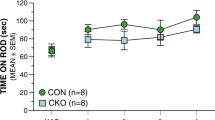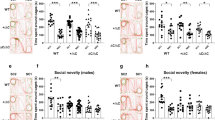Abstract
The present study provides the first quantitative developmental analysis of movement in the weaver (wv/wv) mutant mouse. This autosomal recessive mutation affects both striatal and cerebellar circuitries that are related to motor performance. We report data on postswim grooming behavior in 14 mutant and 14 control animals on alternate postnatal Days 13–20. Mutant animals showed a greater number, but shorter duration, of grooming bouts across this developmental period. The mutant animals also used external support during grooming, expressed various forms of ataxia, performed a higher proportion of smaller forelimb strokes than did the control animals, and failed to complete as many full stereotypic grooming sequences. These differences between mutant and control animals followed distinctive developmental courses. Our data demonstrate that previous anatomical and physiological characterizations of the weaver mutation have overt motor correlates.
Similar content being viewed by others
References
Benecke, R. (1989). The pathophysiology of Parkinson's disease. In Quin, N. P., and Jenner, P. G. (eds.),Disorders of Movement: Clinical, Pharmacological and Physiological Aspects, Academic Press, London, pp. 59–70.
Berntson, G. G., Jang, J. F., and Ronca, A. E. (1988). Brainstem systems and grooming behaviors.Ann. N.Y. Acad. Sci. 525:350–362.
Berridge, K. C. (1990). Comparative fine structure of action: Rules of form and sequence in the grooming patterns of six rodent species.Behaviour 113:21–56.
Berridge, K. C., and Fentress, J. C. (1987a). Disruption of natural grooming chains after striatopallidal lesions.Psychobiology 15:336–342.
Berridge, K. C., and Fentress, J. C. (1987b). Deafferentation does not disrupt natural rules of action syntax.Behav. Brain Res. 23:69–76.
Berridge, K. C., Fentress, J. C., and Parr, H. (1987). Natural syntax rules control action sequence of rats.Behav. Brain Res. 23:59–68.
Blatt, G. J., and Eisenman, L. M. (1985). A qualitative and quantitative light microscopic study of the inferior olivary complex of normal, reeler, and weaver mutant mice.J. Comp. Neurol. 232:117–128.
Colbern, D. L., and Gispen, W. H. (eds.). (1988). Neural mechanisms and biological significance of grooming behavior.Ann. N.Y. Acad. Sci. 525:1–438.
Duvoisin, R. C., (1989). Is there a Parkinson's disease? In Quin, N. P., and Jenner, P. G. (eds.),Disorders of Movement: Clinical, Pharmacological and Physiological Aspects, Academic Press, London, pp. 1–9.
Fentress, J. C. (1972). Development and patterning of movement sequences in inbred mice. In Kiger, J. (ed.),The Biology of Behavior, Oregon State University Press, Corvallis, pp. 83–132.
Ghetti, B., and Triarhou, L. C. (1992). Nigrostriatal aberrations induced by weaver gene are present at birth.22nd Annu. Meet. Soc. Neurosci. 69.1.
Golani, I., and Fentress, J. C. (1985). Early ontogeny of face grooming in mice.Dev. Psychobiol. 18: 529–544.
Goodall, G., and Guastavino, J.-M. (1986). The neurological mutant: Scope and limitations as a tool for the genetic analysis of behaviour. In Médioni, J., and Vaysse, G. (eds.),Genetic Approaches to Behavior, Privat, I.E.C., Toulouse, pp. 59–68.
Hirano, A., and Dembitzer, H. M. (1973). Cerebellar alterations in the weaver mouse.J. Cell Biol. 56:478–486.
Howell, D. C. (1987).Statistical Methods for Psychology, PWS-KENT, Boston.
Lalonde, R. (1987). Motor abnormalities in weaver mutant mice.Exp. Brain Res. 65:479–481.
Lalonde, R., and Botez, M. I. (1986). Navigational deficits in weaver mutant mice.Brain Res. 398:175–177.
Lalonde, R., Manseau, M., and Botez, M. I. (1988). Spontaneous alternation and exploration in weaver mutant mice.Behav. Brain Res. 31:111–114.
Rakic, P., and Sidman, R. L. (1973a). Sequence of developmental abnormalities leading to granule cell deficit in cerebellar cortex of weaver mutant mice.J. Comp. Neurol. 152:103–132.
Rakic, P., and Sidman, R. L. (1973b). Weaver mutant mouse cerebellum: Defective neuronal migration secondary to abnormality of Bergmann glia.Proc. Natl. Acad. Sci. USA 70:240–244.
Robinson, S.R., and Smotherman, W. P. (1992). Motor competition in the prenatal ontogeny of species-typical behaviour.Anim. Behav. 44:89–99.
Roffler-Tarlov, S., and Graybiel, A. M. (1987). The postnatal development of the dopamine-containing innervation of dorsal and ventral striatum: Effects of the weaver gene.J. Neurosci. 7:2364–2372.
Roffler-Tarlov, S., Pugatch, D., and Graybiel, A. M. (1990). Patterns of cell and fiber vulnerability in the mesostriatal system of the mutant mouse weaver. II. High affinity uptake sites for dopamine.J. Neurosci. 10:734–740.
Schmidt, M. J., Sawyer, B. D., Perry, K. W., Fuller, R. W., Foreman, M. M., and Ghetti, B. (1982). Dopamine deficiency in the weaver mutant mouse.J. Neurosci. 2:376–380.
Smeyne, R. J., and Goldowitz, D. (1989). Development and death of external granular layer cells in the weaver mutant cerebellum: A quantitative study.J. Neurosci. 9:1608–1620.
Whishaw, I. Q., Nonneman, A. J., and Kolb, B. (1981). Environmental constrainsts on motor abilities used in grooming, swimming, and eating by decorticate rats.J. Comp. Physiol. Psychol. 95:792–804.
Author information
Authors and Affiliations
Rights and permissions
About this article
Cite this article
Coscia, E.M., Fentress, J.C. Neurological dysfunction expressed in the grooming behavior of developing weaver mutant mice. Behav Genet 23, 533–541 (1993). https://doi.org/10.1007/BF01068144
Received:
Accepted:
Issue Date:
DOI: https://doi.org/10.1007/BF01068144




